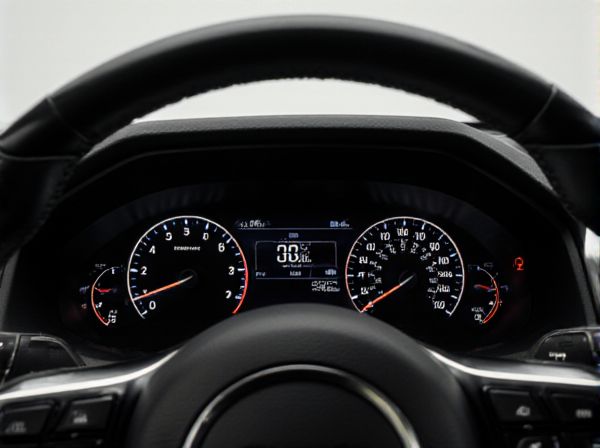
Photo illustration: Analog Gauge Cluster vs Digital Gauge Cluster
Analog gauge clusters provide a classic, easy-to-read display with physical dials and needles, offering immediate visual feedback for speed, fuel, and engine performance. Digital gauge clusters deliver customizable, precise information on a high-resolution screen, allowing you to access a wide range of data beyond traditional metrics. Choosing between the two depends on your preference for traditional tactile controls or modern, versatile displays.
Table of Comparison
| Feature | Analog Gauge Cluster | Digital Gauge Cluster |
|---|---|---|
| Display Type | Mechanical needles with physical dials | LCD/LED screen with customizable interface |
| Readability | Clear in direct sunlight, limited detail | High contrast, adaptable brightness |
| Customization | Fixed layout and design | Fully customizable layouts and themes |
| Data Integration | Basic vehicle info (speed, RPM, fuel) | Comprehensive data (navigation, alerts, efficiency) |
| Maintenance | Low tech, minimal electronic issues | Software updates required, possible glitches |
| Cost | Usually lower cost and simpler design | Higher initial cost, advanced technology |
| Durability | Robust, proven technology | Dependent on electronics and screen quality |
Introduction to Gauge Clusters
Gauge clusters serve as the primary interface for drivers to monitor vehicle performance, providing critical data such as speed, fuel level, and engine temperature. Analog gauge clusters feature mechanical dials with needles, offering a traditional, easy-to-read display that many drivers find intuitive. Digital gauge clusters utilize LCD or OLED screens to deliver customizable, high-resolution information, enhancing visibility and allowing integration with advanced vehicle systems.
What Is an Analog Gauge Cluster?
An analog gauge cluster consists of physical dials and needles to display vehicle information such as speed, RPM, fuel level, and engine temperature. These clusters use mechanical or electromechanical movements to provide real-time data in a clear, intuitive format. Analog gauge clusters offer straightforward readability and a classic design favored in many traditional and performance vehicles.
What Is a Digital Gauge Cluster?
A digital gauge cluster is an advanced automotive dashboard display that uses electronic screens to present information such as speed, fuel level, and engine status with high precision and customization options. Unlike analog gauge clusters that rely on mechanical dials and needles, digital gauge clusters offer dynamic visuals, allowing drivers to switch between different display modes and access real-time data seamlessly. This technology enhances driver experience by integrating features like navigation, media controls, and vehicle diagnostics into a single, easy-to-read interface.
Visual Clarity and Readability
Analog gauge clusters offer intuitive visual clarity with easily distinguishable needle positions and graduated markings, ideal for quick glances in dynamic driving conditions. Digital gauge clusters provide enhanced readability through customizable displays, high-contrast screens, and precise numerical readouts that reduce ambiguity. Both types balance user preference and context-specific needs, with analog favoring simplicity and digital enabling advanced visualization and integration of comprehensive vehicle data.
Customization and User Interface
Analog gauge clusters offer a classic, tactile interface with physical dials and needles, providing intuitive, real-time feedback but limited customization options. Digital gauge clusters utilize high-resolution screens that allow extensive customization of display layouts, colors, and data types, enhancing user interaction and adaptability to driver preferences. The user interface in digital clusters supports dynamic information presentation, whereas analog clusters prioritize simplicity and quick visual reference.
Reliability and Durability
Analog gauge clusters are often praised for their mechanical simplicity, resulting in high reliability and exceptional durability since they have fewer electronic components prone to failure. Digital gauge clusters, while offering advanced features and customizable displays, can be more susceptible to software glitches and electronic malfunctions, potentially impacting long-term dependability. Durability in analog clusters typically excels in extreme conditions due to their robust construction, whereas digital clusters require well-designed hardware and software integration to achieve similar resilience.
Cost and Maintenance Comparison
Analog gauge clusters generally incur lower initial costs due to simpler mechanical components and widespread availability of parts. Digital gauge clusters often require higher upfront investment and specialized maintenance expertise, leading to increased long-term servicing expenses. Maintenance for analog clusters is typically straightforward and less frequent, while digital clusters, with complex electronics and software dependencies, may demand regular updates and costly repairs.
Technological Integration and Features
Analog gauge clusters offer straightforward, mechanical readouts with limited integration capabilities, primarily relying on physical dials and needles for speed, RPM, and fuel level indicators. Digital gauge clusters utilize advanced LCD or OLED screens that enable customizable displays, real-time data visualization, and seamless integration with vehicle telematics, navigation, and driver assistance systems. Enhanced features in digital clusters include adaptive brightness, heads-up display (HUD) compatibility, and the ability to present diagnostic alerts, improving overall driver interaction and vehicle communication.
Aesthetics and Driver Preference
Analog gauge clusters offer a classic, tactile aesthetic favored by drivers who appreciate traditional design and straightforward readability, while digital gauge clusters provide customizable, modern visuals that appeal to tech-savvy users seeking enhanced information display. The choice between analog and digital often hinges on personal preference for simplicity versus advanced functionality, with some drivers valuing the nostalgic feel of analog dials and others prioritizing the dynamic adaptability of digital screens. Both cluster types influence the driving experience, shaping user interaction through design clarity and information accessibility.
Future Trends in Automotive Gauge Clusters
Future trends in automotive gauge clusters emphasize integration of advanced digital displays, blending augmented reality with customizable interfaces to enhance driver information accessibility and safety. Analog gauge clusters are evolving through hybrid designs that combine traditional mechanical dials with digital readouts for improved precision and aesthetic appeal. Emerging technologies such as OLED screens and AI-driven diagnostics are set to redefine user experience by offering real-time data visualization and adaptive display configurations tailored to individual driving conditions.
 caratoz.com
caratoz.com